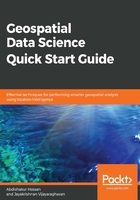
User or customer perspective
Here we will get a clear idea from a customer perspective. Often the following questions will come into picture:
Where does customer X spend his/her time? What does this place offer? How often does he/she visit these places? When does he/she visit these places?
Let's take an example for the UserID = 395 from the fourth row in the preceding table. This particular user has made 106 check-ins in total during this period of the dataset visiting 36 unique venues in NY (visualized as the map as follows):

User 395: Venues visited in NY
We can also look at what type of venues this particular user has visited. In this case, this user has visited frequently an office, a residential building, and a gym, in NYC. Other less-visited venues include an airport, outdoors, a medical center, and many others, as you can see from the following graph:

The user perspective can elicit many aspects related to the frequency of visits, preferences, and activities of the user that can guide location intelligence and decision making. Privacy issues in location data are very sensitive and require diligence. In this case, although it is anonymized data, it still reveals patterns and other useful information as we have shown. Now let's also look from the business perspective in the following section.